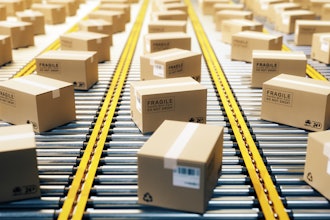
LAS VEGAS – If a company’s supply chain relies on China, it would behoove them to make alternative plans. That was the message delivered by Gene Marks, president of software development company The Marks Group, at this year’s Epicor Insights conference.
Manufacturers and distributors continue to navigate how to combat the latest tariffs introduced by U.S. President Donald Trump, including a 10% baseline on imports, 25% on automotive goods and combined duties on Chinese products that total up to 145%.
During Marks’ presentation, he outlined four actions companies can take to stay afloat in today’s fluid landscape.
1. Diversify Your Supply Chain
While Marks is optimistic that tariff issues with most countries will subside, he predicted that tensions with China would not reach a resolution in the near future.
He directed companies to organizations that can help locate alternative suppliers, including the World Trade Centers Association.
“You give them what materials you are buying, what business you're in and what industry you're in,” Marks said. “They will find alternative suppliers for you. They have this huge, extensive database of suppliers, of all materials all around the world that would be at more tariff friendly places. They will not only identify those suppliers, they will connect you to those suppliers.”
2. Use Bonded Warehouses and Free Trade Zones
Marks described bonded warehouses and free trade zones as “a huge opportunity for distributors and manufacturers.” He noted that many company leaders he has spoken to are already using these resources to avoid paying tariffs.
The U.S. Customs and Border Protection defines a bonded warehouse as a secured area where merchandise can be stored, manipulated or undergo manufacturing operations without payment of duty for up to five years. Furthermore, the duty is not collected until a company withdraws the merchandise for consumption.
“There are a lot of Chinese companies that want to do deals because their orders are falling off a cliff,” Marks said. “So [companies] are buying, they're bringing them into a bonded warehouse, they're not paying any tariffs and then they're waiting to see how the Trump administration is going to negotiate. So when they do pull them out of the warehouses, they'll pay a much lower tariff rate.”
Additionally, if a company cannot find a domestic buyer, it can sell the merchandise for export and avoid paying duties altogether.
 Gene Marks (right) speaks at Epicor Insights 2025 in Las Vegas.Nolan Beilstein
Gene Marks (right) speaks at Epicor Insights 2025 in Las Vegas.Nolan Beilstein
3. Lean into ERP and Software Tools
In an era of higher tariffs, Marks prioritizes protecting margins rather than protecting margin percentages.
“If you're making $30 on a product and it's a 30% margin and then you get a 10% tariff increase, that doesn't mean you just turn around and increase your prices 10%,” Marks said. “You can increase your price and your margin percentage will go down, but your net margin will still be $30.”
Marks called it a “lazy” move to spread tariff-related cost increases across all customers. Instead, he stressed reliance on data from ERP systems.
He laid out a process that starts with generating reports from every customer, allowing for case-by-case decision making. The systems can also provide predictive analysis that shows which products are most exposed to price and tariff increases.
Marks also asked, “Do you increase your prices for the tariffs or do you add a line item because of the tariffs?” He described it as a “debatable topic in the distribution world.”
“Some of my clients are pulling out the tariff increase and showing it separately on an invoice, so that their customers can see that the increase is because of a tariff increase,” Marks said. “It also gives you more flexibility for, hopefully, when these things get resolved. You can pull that line out a lot easier than having to redo all of your prices.
He acknowledged that some companies prefer not to disclose the impact of a tariff and instead use the situation as a cover to raise prices.
4. Get Your Data in Order and Create an AI Policy
Just as companies must make operational changes, they also need to prepare digitally, especially as artificial intelligence reshapes decisions in times of disruption.
Marks listed three actions for companies to take amid the AI revolution. The first is to organize data.
“Take this time to really go through your customer records, your vendor records, your supplier records and clean up your data this year,” Marks said. “You want to have a clean database that [software vendors] can work off of, because there's no way you're going to be relying on agents and automation with lousy data.”
His second point involved asking software vendors “hard questions” to ensure their solutions deliver justifiable value to the business.
Finally, Marks implored companies to create an AI policy that clearly defines what AI apps are permitted, who can use them and how they can and cannot use them. Ironically, he suggested starting with ChatGPT to draft the policy and then refining it through input from legal or IT professionals.
“You need to have a written AI policy because it's getting out of control and it's going to get you into trouble,” Marks said. “AI is great. We all know it’s coming. But it ain’t ready for prime time yet.”



















